by Scott Muniz | Aug 28, 2020 | Uncategorized
This article is contributed. See the original author and article here.
News this week includes:
Internet of Things announced a new series called Ask the IoT Expert. Each month, from September onwards, engineers and specialists will briefly introduce an IoT topic in the Learn IoT discussion section on TC and open it up to users to ask any questions or thoughts relating to that topic.
Transcribe in Word was announced. Transcribe individually separates different speakers so it’s clear which part was said by a teacher versus a student. After the conversation, parts of the recording can be played back by clicking on timestamped audio and the transcript can be edited.
@eguif is our Member of the Week, and a great contributor in the Microsoft Edge Insider community.
View the Weekly Roundup for August 24-28 in Sway and attached PDF document.

by Scott Muniz | Aug 28, 2020 | Uncategorized
This article is contributed. See the original author and article here.
This case started as an issue on SQL on-demand while reading a parquet file. The error was conversion overflows.
Error: Conversion overflows.
So my objective on this post is to describe a possible workaround to read this file in the Spark as also to give some ideas on how to troubleshoot this with the notebook.
Basically I loaded the file on Spark using Scala and it completed successfully:
val sqlContext = new org.apache.spark.sql.SQLContext(sc)
// Create a DataFrame
val df = sqlContext.read.parquet("abfss://<storage>.dfs.core.windows.net/folder/file.parquet")
Display (df.limit(10))
No big deal here. After that, I wanted to check the metadata:
// Print the schema in a tree format
df.printSchema()
You should have a result like the following:

More information you can find here:
https://spark.apache.org/docs/preview/sql-programming-guide.html
Once I found the metadata I used the column name information to run the query against SQL on-demand. With this information, I found the issue was related to a decimal column.
Here some SQL On-demand query tips for conversion issues:
1) You can use schema inferring while querying and by using it you can convert the column datatype. For example, I will convert the decimal column named as column_dec_converted to varchar.
SELECT *
FROM OPENROWSET(
BULK 'https://<storage>.dfs.core.windows.net/folder/file.parquet',
FORMAT='PARQUET' ) WITH ( column_dec_converted varchar(100) ) as rows
2) You can actually apply the convert on the Select Clause as you would do on standard SQL Server:
SELECT cast (column_dec_converted as varchar(100))
FROM OPENROWSET(
BULK https://<storage>.dfs.core.windows.net/folder/file.parquet',
FORMAT='PARQUET' ) as Result
SQL On Demand does not support DML but it fully Supports Select syntax.
That is it!
Liliam C Leme
UK Engineer
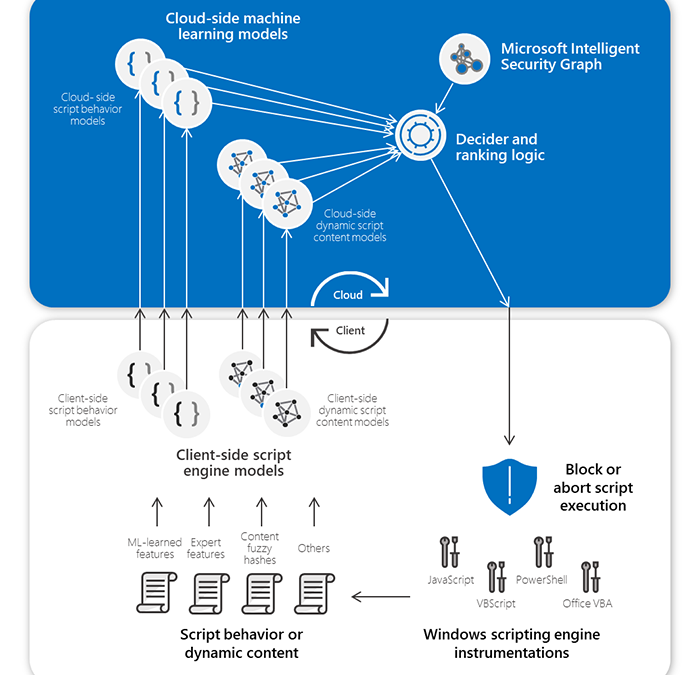
by Scott Muniz | Aug 28, 2020 | Uncategorized
This article is contributed. See the original author and article here.
Behavioral blocking and containment capabilities in Microsoft Defender Advanced Threat Protection (ATP) use protection engines that specialize in detecting and stopping threats by analyzing behavior. One of these engines leverages insights from Antimalware Scan Interface (AMSI), which has visibility into script content and behavior, and pairs of machine learning models on the client and in the cloud working together to detect and stop malicious scripts post-execution.

These pairs of AMSI-powered machine learning classifiers, one pair for each scripting engine, allow Microsoft Defender ATP to detect malicious behavior and stop post-exploitation techniques and other script-based attacks, such as BloodHound and Kerberoasting attacks.
To learn more, read our latest blog post: Stopping Active Directory attacks and other post-exploitation behavior with AMSI and machine learning.
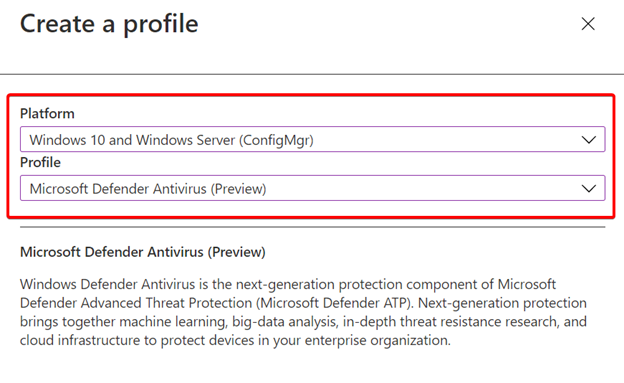
by Scott Muniz | Aug 28, 2020 | Uncategorized
This article is contributed. See the original author and article here.
With the release of Configuration Manager 2006, we’re making another step towards the Microsoft Endpoint Manager admin center being the security policy management tool for ConfigMgr standalone clients.
Microsoft Defender Antivirus policies for Windows can now be managed from the Endpoint security node of Microsoft Endpoint Manager (MEM) and targeted to on-premises Configuration Manager collections.
This allows your security admins to target both cloud-born MDM devices, Intune + ConfigMgr co-managed devices and ConfigMgr only clients.
To start, ensure you have Tenant Attach enabled. Once enabled, sync some ConfigMgr collections into MEM, which will make them available for configuration targeting.
Once this is done, browse to the http://endpoint.microsoft.com admin center, select Endpoint security > Antivirus
Select Create Policy
Select Windows 10 and Windows Server (ConfigMgr) as the Platform, and Windows Defender Antivirus (Preview) for the Profile, and select Create.

Give the policy a name, and configure your desired settings
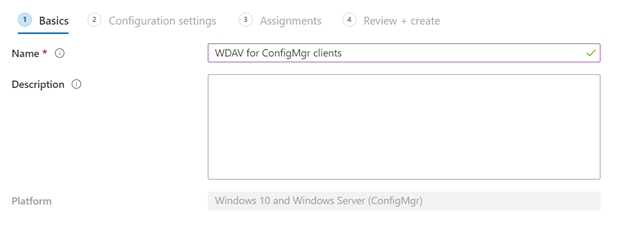
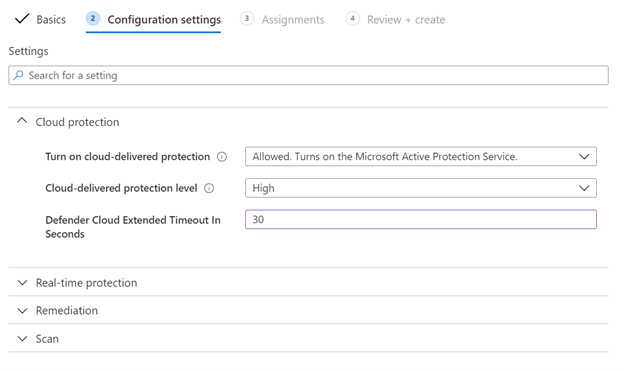
Now select some collections to target and finish the wizard. Once complete, MEM will sync down the policy configuration to ConfigMgr, including the collection assignments.
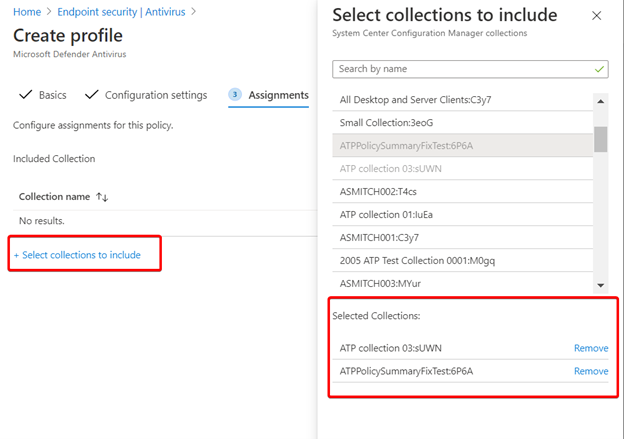
The configuration will apply to the devices in the collection, and report back it’s status in both Configuration Manager and in the MEM console.
In ConfigMgr Monitoring > Deployments

In Endpoint Manager policy > Overview
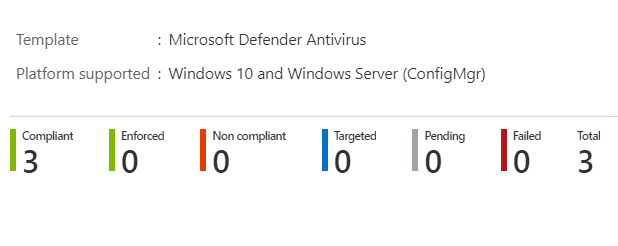
To learn more about this feature, please see our documentation.
by Scott Muniz | Aug 28, 2020 | Uncategorized
This article is contributed. See the original author and article here.
Visit www.aha.org and www.aonl.org for more info
Claire Bonaci: The World Health Organization designated 2020 as the year of the nurse and midwife to raise awareness of nurses and midwives significant and varied roles in healthcare. Today, Molly talks with Dr. Robyn Begley, the chief nursing officer for the American Hospital Association and the CEO of the American organization for nursing leadership.
Molly McCarthy: So hi, I’m Molly McCarthy with Microsoft. Microsoft and the American Hospital Association are partnering together to educate nurses and physicians on artificial intelligence in healthcare. Our mutual goal is to raise awareness and increase understanding of the scope of artificial intelligence, highlighting clinical and administrative use cases, as well as provide continuing education credits for both physicians, nurses and hospital administrator. And I’m so excited to be here today with Dr. Robyn Begley, who is the chief nursing officer for the American Hospital Association, as well as the CEO for AONL. Welcome, Robyn.
Robyn Begley: Hi, Molly. It’s great to be here.
Molly McCarthy: Thank you so much for joining us today. It’s really been a pleasure working with you and the American Hospital Association over the past year to put this course together and would just love to hear from you. You know, tell me a little bit more about yourself and your journey to the AHA. I know, we were talking earlier about the amount of time we’ve both been in health care. So we’d love to hear a little bit more about your background.
Robyn Begley: Sure. Thank you, Molly. Well, I’ve been in health care a little bit longer than you have. But prior to my role here at the AHA and AONL, I began here almost two years ago in September. I was the chief nursing officer for a healthcare system in southeastern New Jersey. Spent most of my professional career there but the last 20 years I was a chief nursing officer. My clinical background is the Maternal Child field which I began you know, after graduation, a number of years ago and spent some time in, in labor and delivery, the NICU different aspects of ob gyn.
Molly McCarthy: Great. That’s another thing we have in common because I started out in the neonatal intensive care unit worked in pedes, and pediatric cardiology. So definitely a special place in my heart for the Maternal Child area. In thinking about the course that is getting ready to launch wanted to hear from you, you know, specifically based upon your experience as a chief nursing officer, for many years within within the healthcare industry, just the importance of providing clinical content around artificial intelligence and technology to our nurses and physicians, as well as healthcare administrators, and really talk a little bit more about the significance of this program.
Robyn Begley: Thanks, Molly. That’s a great question. In my role as chief nursing officer, I learned you know firsthand what, what big decisions are made regarding the future, whether it’s technology, whether it’s AI, and I know that, you know, many times I felt unprepared for the decisions to be that I needed to weigh in on. So I think, you know, a course like this really provides the, the building blocks of it doesn’t tell you necessarily what you it’s not very prescriptive, but what it does is really gives you the information that you need to then make appropriate decisions. Not only just information, factual information, but also what processes to consider and who needs to be included. And I think in particular, what resonated with me was the whole issue of your culture. So every organization has a different culture and how to you know how to set the decision making process up for success, you know, and decisions are around implementation, etc. It was really, I think it was really a great coming together of both the technical side and the administrative and the clinical side. So I’m very proud, you know that we’re going to be able to offer this, this program together.
Molly McCarthy: Well, great, really great points that you’re making. And I think you mentioned kind of that trifecta of technical, clinical and administrative. And I think that’s so important when thinking about technology, not just the implementation piece, but really thinking about what’s right for our organization and making those decisions because not only do they impact the IT group, but certainly the clinicians and ultimately the patients. And just kind of a follow up question to that, obviously, the importance of the continuing education and having that credit available through this course. But really thinking about today’s environment, the herein here, you know, and now and what’s going on in the world? And just Can you talk a little bit about what you’ve seen in terms of the the shift in technology, from your perspective within, you know, within the many hospitals that you work with across the US?
Robyn Begley: Well, it’s a Yes, I’m happy to address that. In speaking with nursing leaders across the country and clinical leaders, not you know, not just nurses, although that certainly is, you know, the group that I mainly interact with. We have heard from everyone that, you know, the, the crisis of the pandemic has has spurred innovation. And one of those things that we see across the country is adoption of technology that maybe has been around for a little while, but there was a lot of, you know, formerly there was reservation, about using things and this technology has been adopted and innovated, so rapidly given You know, given the pandemic, and I think that, you know, both patients have been much more accepting of technology. And I think our clinical caregivers understand that it can really help maximize their not just their, their ability to care for more patients, but care for more patients safely. And how can they really utilize this technology in new ways to, you know, to take care of more patients, and, you know, extend their reach out into the community more rapidly. And that’s been a really great thing. You know, I call I call that a silver lining of the pandemic. We have seen some really, you know, we have seen some benefits, although, of course, you know, we’re dealing with a lot of still in the middle of a lot of, you know, really uncertain times.
Molly McCarthy: Right, Yeah, And I think you know, from me from my standpoint, I’ve been at Microsoft for over seven years and been talking about cloud technology and most certainly virtual health and virtual visits, etc, for a good six years and just to see the adoption rate in the past six months has, you know, trumped the the past six years. So like you said silver lining. Just a couple more questions here as we close out. One is have you taken the course yourself I know that I looked obviously been involved in the course and thinking about the the expertise we needed to put it together but and had a chance last month to look at it and take it and just wanted to see if you’ve taken the course and kind of from your perspective, the outcomes that maybe you’re looking for, for yourself and even nursing leadership.
Robyn Begley: Well, I did take it. I actually went online and and reviewed the whole course. And I thought it was really very thought provoking in addition to providing with me with a lot of information, and it was very user friendly. It’s a really It was very enjoyable to do. And I know with our continuing education required, you know, for our licensure, etc. Some things aren’t as, you know, as pleasant, and you know, and pleasurable, but this was I really felt like I learned a lot by completing the courses. And, you know, you can take your time with it. You know, it has different formats, so that it’s not all just one way of delivering the information. So I just thought it was really, you know, it was really informative. And I hope that it’s well, well accepted by our, you know, by our field, I think it will be because it’s really a pleasure to learn in this way.
Molly McCarthy: Welll great. Thank you so much. Appreciate. Appreciate that candor. And just as we wrap up here. I know that you have a big meeting coming up in the end of September and wanted to hear a little bit more about that and how people can can get involved in that.
Robyn Begley: Sure. Thank you very much, Molly. Speaking of Technology. Of course, we had to cancel our annual meeting that was scheduled for March in person. So we are holding our virtual conference for AONL, the American organization for nursing leadership on September 24. If you go to our website aonl.com, you will be able to learn all you need to know if you’d like to register for our virtual conference, we have our keynote speakers who were to have, you know, presented in March that we’ll be presenting in September as well as many of our breakout groups and again, it’s a great opportunity for continuing education.
Molly McCarthy: That’s great. Well, thank you so much for taking time out of your busy schedule today. I certainly appreciate your expertise and look forward to continued partnership with you. So thank you.
Robyn Begley: My pleasure, Molly. Thank you.
Claire Bonaci: Thank you all for watching. Please feel free to leave us questions or comments below and check back soon for more content from the HLS industry team.
by Scott Muniz | Aug 28, 2020 | Uncategorized
This article is contributed. See the original author and article here.
Visit www.aha.org and www.aonl.org for more info
Claire Bonaci: The World Health Organization designated 2020 as the year of the nurse and midwife to raise awareness of nurses and midwives significant and varied roles in healthcare. Today, Molly talks with Dr. Robyn Begley, the chief nursing officer for the American Hospital Association and the CEO of the American organization for nursing leadership.
Molly McCarthy: So hi, I’m Molly McCarthy with Microsoft. Microsoft and the American Hospital Association are partnering together to educate nurses and physicians on artificial intelligence in healthcare. Our mutual goal is to raise awareness and increase understanding of the scope of artificial intelligence, highlighting clinical and administrative use cases, as well as provide continuing education credits for both physicians, nurses and hospital administrator. And I’m so excited to be here today with Dr. Robyn Begley, who is the chief nursing officer for the American Hospital Association, as well as the CEO for AONL. Welcome, Robyn.
Robyn Begley: Hi, Molly. It’s great to be here.
Molly McCarthy: Thank you so much for joining us today. It’s really been a pleasure working with you and the American Hospital Association over the past year to put this course together and would just love to hear from you. You know, tell me a little bit more about yourself and your journey to the AHA. I know, we were talking earlier about the amount of time we’ve both been in health care. So we’d love to hear a little bit more about your background.
Robyn Begley: Sure. Thank you, Molly. Well, I’ve been in health care a little bit longer than you have. But prior to my role here at the AHA and AONL, I began here almost two years ago in September. I was the chief nursing officer for a healthcare system in southeastern New Jersey. Spent most of my professional career there but the last 20 years I was a chief nursing officer. My clinical background is the Maternal Child field which I began you know, after graduation, a number of years ago and spent some time in, in labor and delivery, the NICU different aspects of ob gyn.
Molly McCarthy: Great. That’s another thing we have in common because I started out in the neonatal intensive care unit worked in pedes, and pediatric cardiology. So definitely a special place in my heart for the Maternal Child area. In thinking about the course that is getting ready to launch wanted to hear from you, you know, specifically based upon your experience as a chief nursing officer, for many years within within the healthcare industry, just the importance of providing clinical content around artificial intelligence and technology to our nurses and physicians, as well as healthcare administrators, and really talk a little bit more about the significance of this program.
Robyn Begley: Thanks, Molly. That’s a great question. In my role as chief nursing officer, I learned you know firsthand what, what big decisions are made regarding the future, whether it’s technology, whether it’s AI, and I know that, you know, many times I felt unprepared for the decisions to be that I needed to weigh in on. So I think, you know, a course like this really provides the, the building blocks of it doesn’t tell you necessarily what you it’s not very prescriptive, but what it does is really gives you the information that you need to then make appropriate decisions. Not only just information, factual information, but also what processes to consider and who needs to be included. And I think in particular, what resonated with me was the whole issue of your culture. So every organization has a different culture and how to you know how to set the decision making process up for success, you know, and decisions are around implementation, etc. It was really, I think it was really a great coming together of both the technical side and the administrative and the clinical side. So I’m very proud, you know that we’re going to be able to offer this, this program together.
Molly McCarthy: Well, great, really great points that you’re making. And I think you mentioned kind of that trifecta of technical, clinical and administrative. And I think that’s so important when thinking about technology, not just the implementation piece, but really thinking about what’s right for our organization and making those decisions because not only do they impact the IT group, but certainly the clinicians and ultimately the patients. And just kind of a follow up question to that, obviously, the importance of the continuing education and having that credit available through this course. But really thinking about today’s environment, the herein here, you know, and now and what’s going on in the world? And just Can you talk a little bit about what you’ve seen in terms of the the shift in technology, from your perspective within, you know, within the many hospitals that you work with across the US?
Robyn Begley: Well, it’s a Yes, I’m happy to address that. In speaking with nursing leaders across the country and clinical leaders, not you know, not just nurses, although that certainly is, you know, the group that I mainly interact with. We have heard from everyone that, you know, the, the crisis of the pandemic has has spurred innovation. And one of those things that we see across the country is adoption of technology that maybe has been around for a little while, but there was a lot of, you know, formerly there was reservation, about using things and this technology has been adopted and innovated, so rapidly given You know, given the pandemic, and I think that, you know, both patients have been much more accepting of technology. And I think our clinical caregivers understand that it can really help maximize their not just their, their ability to care for more patients, but care for more patients safely. And how can they really utilize this technology in new ways to, you know, to take care of more patients, and, you know, extend their reach out into the community more rapidly. And that’s been a really great thing. You know, I call I call that a silver lining of the pandemic. We have seen some really, you know, we have seen some benefits, although, of course, you know, we’re dealing with a lot of still in the middle of a lot of, you know, really uncertain times.
Molly McCarthy: Right, Yeah, And I think you know, from me from my standpoint, I’ve been at Microsoft for over seven years and been talking about cloud technology and most certainly virtual health and virtual visits, etc, for a good six years and just to see the adoption rate in the past six months has, you know, trumped the the past six years. So like you said silver lining. Just a couple more questions here as we close out. One is have you taken the course yourself I know that I looked obviously been involved in the course and thinking about the the expertise we needed to put it together but and had a chance last month to look at it and take it and just wanted to see if you’ve taken the course and kind of from your perspective, the outcomes that maybe you’re looking for, for yourself and even nursing leadership.
Robyn Begley: Well, I did take it. I actually went online and and reviewed the whole course. And I thought it was really very thought provoking in addition to providing with me with a lot of information, and it was very user friendly. It’s a really It was very enjoyable to do. And I know with our continuing education required, you know, for our licensure, etc. Some things aren’t as, you know, as pleasant, and you know, and pleasurable, but this was I really felt like I learned a lot by completing the courses. And, you know, you can take your time with it. You know, it has different formats, so that it’s not all just one way of delivering the information. So I just thought it was really, you know, it was really informative. And I hope that it’s well, well accepted by our, you know, by our field, I think it will be because it’s really a pleasure to learn in this way.
Molly McCarthy: Welll great. Thank you so much. Appreciate. Appreciate that candor. And just as we wrap up here. I know that you have a big meeting coming up in the end of September and wanted to hear a little bit more about that and how people can can get involved in that.
Robyn Begley: Sure. Thank you very much, Molly. Speaking of Technology. Of course, we had to cancel our annual meeting that was scheduled for March in person. So we are holding our virtual conference for AONL, the American organization for nursing leadership on September 24. If you go to our website aonl.com, you will be able to learn all you need to know if you’d like to register for our virtual conference, we have our keynote speakers who were to have, you know, presented in March that we’ll be presenting in September as well as many of our breakout groups and again, it’s a great opportunity for continuing education.
Molly McCarthy: That’s great. Well, thank you so much for taking time out of your busy schedule today. I certainly appreciate your expertise and look forward to continued partnership with you. So thank you.
Robyn Begley: My pleasure, Molly. Thank you.
Claire Bonaci: Thank you all for watching. Please feel free to leave us questions or comments below and check back soon for more content from the HLS industry team.





Recent Comments